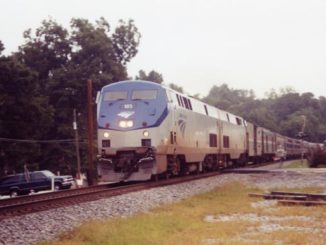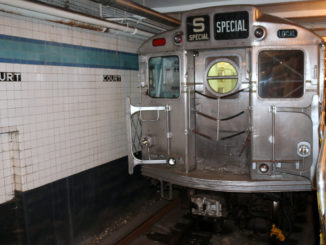NEW YORK – MTA New York City Transit’s legendary Redbirds have made their farewell journey – the last 11-car train of Tuscan-red cars operated Nov. 3 on the Flushing Line between Times Square and Willets Point before being permanently retired from service.
About three years ago, there were more than 1,400 Redbirds of various vintages serving many of NYC Transit’s A Division routes (numbered lines). However, with the MTA’s $2 billion capital investment in more comfortable and reliable high-tech subway cars the number of Redbirds on the system has dwindled.
Their last stronghold was along the No. 7 Flushing Line, where the cars have operated since 1963.
Lately, they’ve become the stuff of urban curiosity and interest in them grew especially as their numbers decreased. Of course, one of the main things subway riders will miss are the metal hand straps once so common in New York City subway cars. The Redbird fleet was the last to have them.
“Even for those of us who tend to be nostalgic, the retirement of the Redbirds has a lot more bearing on the future than the past,” said MTA Chairman Peter S. Kalikow. “Through the funding provided by our capital programs we have invested nearly $2 billion in the purchase of new subway cars from 2000 through 2004.”
Since 2000, NYC Transit, Kalikow said, customers have benefited from the purchase of 1,400 new technology subway cars. Partial funding for the new R142, R142a and R143 cars currently in service was provided through grants from the Federal Transit Administration. Overall, major investments have also been made in the areas of station rehabilitation, track replacement and signal modernization.
Substantial Capital Program funding has also been invested in the facilities where subway trains and buses are stored, maintained and overhauled. Replacing the Redbirds on the Flushing Line are stainless steel R62A class cars manufactured in 1985 by Bombardier.
“With the phase-in of these stainless-steel cars, Flushing Line customers are riding on brighter, more modern equipment with an excellent reputation for reliability,” said NYC Transit President Lawrence G. Reuter. “We can’t guarantee the outcome of a Mets game, but the R62As should make the ride to and from Shea Stadium that much more pleasurable.”
Historically, NYC Transit’s Redbird fleet was made up of six similar car classes manufactured between 1959 and 1963. During their service lives they sported several different paint jobs. While the pictured-window Flushing Line cars were the only ones to wear the fancy blue and cream design created for the World’s Fair, all were painted MTA silver and blue in the 1970s and then all white in the early 1980s.
The cars were finally painted red and dubbed “Redbirds” when the fleet was overhauled and cleansed of painted graffiti between 1984 and 1989.
The last Redbirds in passenger service were also the last to be manufactured. Built between 1963 and 1964 by the St. Louis Car Company, the 51-foot 75,600-pound R33 and R36 cars were assigned to the No. 7 line in time for the 1964 World’s Fair at Flushing Meadows-Corona Park.
“The ‘Redbird’ fleet has performed beyond our wildest expectations,” Reuter said. “But the fact of the matter is that they are obsolete equipment, and have outlived their usefulness. The time has come to retire them in favor of cars that are more modern and more dependable.”
In the past, subway cars were auctioned off to scrap metal dealers. Over the last several years, however, the cost of preparing obsolete equipment for sale has skyrocketed. But a little over two years ago, the creative thinkers in Materiel’s Asset Recovery Unit came up with the idea of using the 51-foot cars as reef material rather than just selling them off for scrap. The majority of the Redbirds have been the basis of an artificial reef program off the shores of several states along the eastern seaboard.
Before the cars can be sunk, though, the trucks and all interior components are removed, including windows, doors, air gauges, car number boards, route signs, and handholds. Some of the material removed is being used as spares for older cars that still remain in service, but the great majority of the items had no further use for NYC Transit.
Since the inception the Reef Program, several states have requested the cars for placement off their shores. Delaware was first, with South Carolina, Georgia, and Virginia making the move soon after. Recently, New Jersey requested 200 cars that will be sunk along the ocean floor. So far, nearly 1,000 cars have been placed and sea life is teeming in those locations.
Materiel’s Mike Zacchea, who oversees NYC Transit’s Artificial Reef Program watched as piles of removed items were collected at the 207th Street Maintenance Facility. He thought that it would be a waste to simply scrap the old items.
“From time to time we have received calls from collectors seeking to purchase items from the old cars,” Zacchea said. “We took a look at the materials being stripped from the cars and realized that there might just be a market for these pieces of New York City history.”
Among the items up for sale are front and side destination roll signs, air horns, front express and local signs, customer handholds, emergency brake valves, controllers, air gauges, and stanchion poles.
“There are quite a few interesting items here for sale. Not enough to build a New York City subway car, but it’s a pretty impressive start,” Zacchea said, adding the materials are removed from the cars as they are prepared for shipment to reef locations.
Each item comes complete with a certificate of authenticity, noting that it was once part of a genuine New York City subway car. Anyone interested in purchasing a piece of history can reach the Asset Recovery Unit by calling 800-543-8258.




